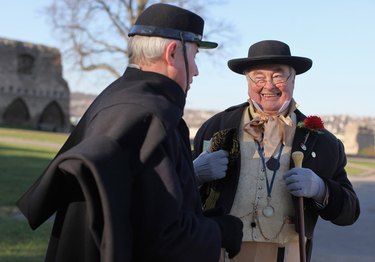
Charles Dickens wrote A Christmas Carol during the Victorian era when class divisions in England separated the wealthy from the poor. This social distinction was reflected in clothing, from the elegant velvet and brocade outfits of the privileged to the tattered clothing of the disadvantaged. Whether you're costuming a play for your local theater group or dressing for your own DIY Christmas party this holiday season, select authentic A Christmas Carol costume ideas from whatever rank of society you choose.
Dress as Mrs. Fezziwig
Video of the Day
Mrs. Fezziwig and her daughters dressed in the elegant holiday style suitable for their class. Victorian ladies of means attending the Fezziwigs' holiday party ball would have worn scoop-necked dresses with puffy sleeves, narrow bodices with pointed waists and full skirts—bell-shaped from the hoop skirt they wore underneath. You can achieve the same fullness by wearing a square-dancing slip.
Video of the Day
Outdoors, ladies always wore bonnets. Their hair would have been done in ringlets, and they might have wrapped a fringed shawl around their shoulders. Use ribbons, ruffles, lace and velvet accents as decorations for dresses to create A Christmas Carol outfits for Mrs. Fezziwig and the other ladies.
Tip
Ribbons, lace, and velvet were frequent accents on the Victorian dresses of upper-class ladies.
Scrooge's nephew, Fred
The epitome of a young gentleman, Ebenezer Scrooge's nephew, Fred, would have dressed exceptionally well for the ball. Fred's costume might include a black top hat, straight, snug trousers in a neutral shade, and boots. To achieve the look of a Victorian dress shirt, tie a dark silk scarf under the collar of a white shirt to keep the collar raised. Gentlemen in the early part of the Victorian age would have worn a fancy vest over the shirt, possibly made of brocade with a floral pattern or other design. Top it off with a dark, formal cutaway coat with tails in the back for an authentic Victorian costume.
Bob Cratchit costume
A working-class man with a family to feed, Bob Cratchit would have dressed conservatively in a white shirt and black trousers when he went to his job at Scrooge's counting house. Although poor, he probably would have had a worn black hat and coat to look respectable. While his clothes were washed, they would have shown signs of age and wear.
Other working-class people who did heavy labor in the 19th century tended to look scruffy. To dress like one of Dickens' working-class men, wear a work shirt with the sleeves rolled up and pants with suspenders. Working-class women's dresses were dark and plain with long sleeves. They were less elegant than those of upper-class women and they were worn without a hoop skirt and often with an apron.
Tip
Working-class Victorian outfits often looked well-worn and old.
Tiny Tim: Bless us one and all
Victorian children traditionally wore clothing that mimicked the clothes of their elders. A boy like Tiny Tim, who lived in poverty, would have worn the same outfit every day: a ragged jacket over a plain shirt, with knickers that reached just below his knees instead of long pants. He might have had a small-brimmed hat or cap on his head. The look was respectable but worn. Upper-class young Victorian gentlemen wore dress shirts, vests, pants and jackets, with younger boys in shorter pants. Privileged young girls wore ruffled fancy dresses that buttoned in the back and had puffy sleeves, often with a pinafore over them and ruffled pantalettes underneath, with their hair in banana curls.
Whether you choose to emulate a happy Victorian Christmas or the humbug attitude of Scrooge, your holiday party is bound to be fun if everyone dresses the part.